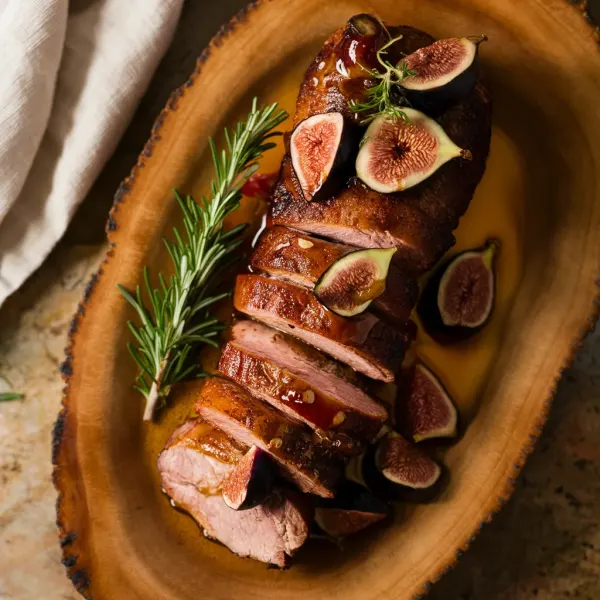
 30 minutes
30 minutesA delicious pork tenderloin dish served with a rich fig and bourbon sauce.


Dried Figs, split in half lengthwise
cups
Bourbon
cups
Powdered Gelatin
teaspoons
Chicken Stock, low-sodium
cups
Pork Tenderloin, trimmed of silverskin
0 lb
to taste
to taste
cups
tablespoons
Shallots, minced
each
Whole Grain Mustard
tablespoons
cups
pinches
tablespoons
1. Soak Figs and Bloom Gelatin
Place the dried figs in a small bowl and pour the bourbon over them, letting them soak and plump up. In another small bowl, sprinkle the powdered gelatin over the chicken stock and set it aside to bloom.
2. Season and Dredge Pork
Season the pork tenderloin generously with kosher salt and freshly ground black pepper. Spread the cornstarch on a plate and dredge the seasoned pork in it to coat evenly.
3. Sear Pork
Heat the vegetable oil in a 10-inch stainless steel skillet over medium-high heat. When the oil is shimmering, add the pork tenderloin. Sear the pork, turning occasionally, until it is well browned on all sides, about 8 minutes.
4. Cook Shallots and Flambé
Once the pork is browned, add the minced shallot to the skillet and cook until fragrant. Pour in the bourbon-fig mixture and carefully ignite it to flambé. Let the flames die out.
5. Make Sauce
Add the gelatin-infused chicken stock, whole grain mustard, maple syrup, and a pinch of cayenne pepper to the skillet. Whisk everything together until well combined.
6. Simmer Pork
Reduce the heat to medium and return the pork tenderloin to the skillet. Let it simmer gently, turning occasionally, for 6 to 10 minutes. Check the internal temperature of the pork; it should read 130-135°F for medium rare or 140-145°F for medium well.
7. Rest Pork
Remove the pork from the skillet and set it aside to rest for about 4 minutes.
8. Thicken Sauce
Increase the heat under the skillet to high and add the unsalted butter. Let the sauce boil and reduce for about 4 minutes, until it thickens slightly.
9. Serve
Slice the rested pork tenderloin and arrange it on a serving platter. Generously spoon the fig and bourbon sauce over the top. Serve immediately.
Chicken, Beef Tenderloin, Salmon, Tofu or Seitan can all be substituted for the pork tenderloin to suit different dietary preferences or taste profiles.
Whiskey-Peach Glaze, Balsamic-Honey Glaze, Maple-Mustard Glaze . these are all options that can be swapped in to give the dish a new dimension.
Introducing a different acidic component to the glaze can alter the flavor profile. Balsamic vinegar can replace apple cider vinegar for a richer, deeper sweetness with a tart edge. Alternatively, a splash of citrus juice like orange or pomegranate could add a bright note.
Swap out the brown sugar for maple syrup or honey for a different kind of sweetness that will caramelize beautifully on the pork.
Grilling or Sous Vide are alternative cooking methods that can bring out different flavors and textures in the protein.




Comments (0)